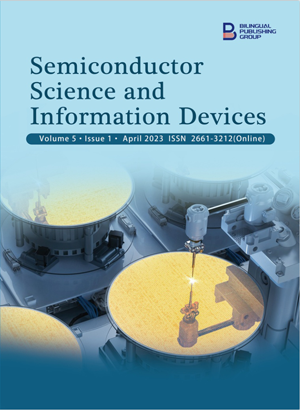Analysis of the Effect of Radiation Defects by Low-energy Protons on Electrophysical Properties of Silicon N+ -P-P+Structure
DOI:
https://doi.org/10.30564/ssid.v5i1.6014Abstract
Nowadays, radiation engineering is a promising direction in the creation of semiconductor devices. The proton irradiation is used to controllably change the optical, electrical, recombination, mechanical and structural properties of the semiconductors. Low-energy protons make it possible to purposefully change material properties near the surface where the n+ -p junction is located. In this paper, the impact of low-energy protons on the electro physical parameters of n+ -p-p+ silicon photoelectric converters (SPC) is analyzed. The current-voltage characteristics and switching time of these SPCs are measured. The switching time is determined using rectangular bipolar voltage pulses with an amplitude of 10 mV, a frequency of 200 kHz, or a frequency of 1 MHz. A theoretical and experimental analysis of the obtained results is performed. The comparison of experimental data with the results of calculations shows that protons with an energy of 180 keV and a dose of 1015 cm–2 create two regions in the space charge region of the n+ -p junction with different switching times of 4.2 × 10–7 s and 5.5 × 10–8 s. SPC frequency characteristics have been improved by reducing the effective lifetime by 5-10 times. This effect can be used to create high-speed photodiodes with an operating modulation frequency of 18 MHz.
Keywords:
Silicon; n -p junction; Lifetime; Proton; Pulse characteristicReferences
[1] Abdullaeva, I.A., Abdinova, G.D., Tagiyev, M.M., et al., 2021. Effect of gamma irradiation on the electrical properties of extruded Bi85Sb15<Те> samples. Inorganic Materials. 57, 887-892.
[2] Li, J., Aierken, A., Liu, Y., et al., 2021. A brief review of high efficiency III-V solar cells for space application. Frontiers in Physics. 8, 631925.
[3] Siddiqui, A., Usman, M., 2021. Proton irradiation in simplified PERC silicon solar cells: A simulation-based framework. ECS Journal of Solid State Science and Technology. 10(5), 055007.
[4] Weiss, C., Park, S., Lefèvre, J., et al., 2020. Electron and proton irradiation effect on the minority carrier lifetime in SiC passivated p-doped Ge wafers for space photovoltaics. Solar Energy Materials and Solar Cells. 209, 110430.
[5] Serge, T.G., Bernard, Z., Bruno, K., et al., 2019. Theoretical study of proton radiation influence on the performance of a polycrystalline silicon solar cell. International Journal of Photoenergy. 1-7.
[6] Gubarev, V.N., Semenov, A.Y., Surma, A.M., et al., 2011. Applying proton irradiation for performance improvement of power semiconductors. Power Electronics Europe. 3, 35-38.
[7] Anfimov, I.M., Kobeleva, S.P., Pylnev, A.V., et al., 2017. On the problem of determining the bulk lifetime by photoconductivity decay on the unpassivated samples of monocrystalline silicon. Russian Microelectronics. 46, 585-590.
[8] Koshelev, O.G., Vasiljev, N.G., 2017. Separate determination of the photoelectric parameters of n+ -p (n)-p+ silicon structure base region by non contact method based on measurements of quantum efficiency relationships at two wavelengths. Modern Electronic Materials. 3(3), 127-130.
[9] Sam, R., Zouma, B., Zougmoré, F., et al., 2012. 3D determination of the minority carrier lifetime and the pn junction recombination velocity of a polycrystalline silicon solar cell. IOP Conference Series: Materials Science and Engineering. 29(1), 012018.
[10] Bscheid, C., Engst, C.R., Eisele, I., et al., 2019. Minority carrier lifetime measurements for contactless oxidation process characterization and furnace profiling. Materials. 12(1), 190.
[11] Kozlov, V.A., Kozlovski, V.V., 2001. Doping of semiconductors using radiation defects produced by irradiation with protons and alpha particles. Semiconductors. 35, 735-761.
[12] Agafonov, Y.A., Bogatov, N.M., Grigorian, L.R., et al., 2018. Effect of radiation-induced defects produced by low-energy protons in a heavily doped layer on the characteristics of n+ -p-p+ Si structures. Journal of Surface Investigation: X-ray, Synchrotron and Neutron Techniques. 12, 499-503.
[13] Bogatov, N.M., Grigorian, L.R., Kovalenko, A.I., et al., 2020. Influence of radiation defects induced by low-energy protons at a temperature of 83 K on the characteristics of silicon photoelectric structures. Semiconductors. 54, 196-200.
[14] Bogatov, N.M., Grigor’yan, L.R., Kovalenko, A.I., et al., 2021. Pulse response characteristics of silicon photovoltaic converters irradiated with low-energy protons. Technical Physics Letters. 47(4), 326-328.
[15] Hu, Z., Hernández, D.M., Martinez, S.N., 2022. Analysis of radiation effects of semiconductor devices based on numerical simulation Fermi-Dirac. Nonlinear Engineering. 11(1), 252-259.
[16] Wen, Y., Zhou, J., 2019. Metamaterial route to direct photoelectric conversion. Materials To day. 23, 37-44.
[17] Vasilevich, U.P., Nguyen, V.Z., Dziatlau, Y.K., 2018. Photoelectric converter for monitoring lighting systems. Doklady BGUIR. (7), 144-148.
[18] Zhu, M., Liu, X., Wang, Y., et al., 2022. Re-search and design of photoelectric converter for quantum gravimeter. Journal of Physics: Conference Series. 2383(1), 012032.
[19] Bogatov, N., Grigoryan, L., Klenevsky, A., et al., 2020. Modelling of disordering regions in proton-irradiated silicon. Journal of Physics: Conference Series. 1553(1), 012015.
[20] Harutyunyan, V., Sahakyan, A., Manukyan, A., et al., 2023. Introduction rates of electrically active radiation defects in proton irradiated n-type and p-type Si monocrystals. Journal of Electronic Materials. 1-8.
[21] Shockley, W., 1949. The theory of p-n junctions in semiconductors and p-n junction transistors. Bell System Technical Journal. 28(3), 435-489.
[22] Fahrenbruch, A., Bube, R., 2012. Fundamentals of solar cells: Photovoltaic solar energy conversion. Elsevier: Amsterdam.
Downloads
How to Cite
Issue
Article Type
License
Copyright © 2023 Bogatov N. M., Grigoryan L. R., Kovalenko M. S., Volodin V. S.

This is an open access article under the Creative Commons Attribution-NonCommercial 4.0 International (CC BY-NC 4.0) License.




 Aims and Scope
Aims and Scope Bogatov N. M.
Bogatov N. M.






